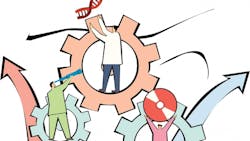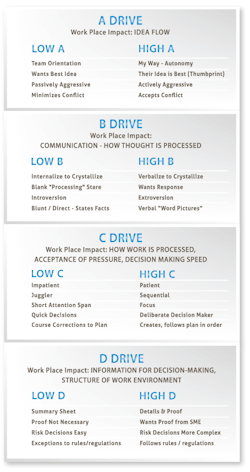What I Learned From Taking the Employee Pre-hiring Assessment Survey
The assessment survey looked simple enough, a two page list of words, checkbox format, available online.
Without even thinking, I sat down to fill it out and, boom! I was done.
I’ve taken these surveys before—Personalysis (I jimmied it), some Meyer Briggs in grad school—I already knew what I was going to do after graduation.
But this one was different.
My friends John Sammut, CEO of Firstronic LLC, and Jay Hawreluk, CEO of AcuMax, told me it’s all about the wiring—and as a dyslexic, I definitely knew about the wiring—the programming that has to happen to complete new tasks.
But I have to say that at the conclusion of this process I felt that someone who knew me—my very opposite rocket scientist husband—had slipped them the answers. It was that accurate!
It’s all in the wiring—what our brains are best set up to do—determines how well we fit certain jobs."— James "Jay" Hawreluk, CEO, AcuMax
So what did I learn from two pages of checkboxes on the AcuMax Index? Although I have worked in production, electronics assembly is not for me, according to AcuMax. It says I like challenge, love my freedom, need loosely formed projects to dig into; that I like urgency, multi-tasking, etc.
All this from a survey whose average time to complete is 4.6 minutes!
“When you try to change who you are," Hawreluk explains, “that takes energy—energy that detracts from the job at hand.“
“But could I work on assembly line?” I asked.
“Sure," Hawreluk answered. “I can train you all day long to be the greatest assembly worker ever, but you would stick to that job for one reason only—the money. You’d be very unhappy, you’d be looking for other things."
He continued: "It’s all in the wiring—what our brains are best set up to do—determines how well we fit certain jobs. You might see great people hired and trained for specific jobs, but many of them don’t perform as expected or they leave. We want to help identify the right fit before it goes that far."
He singles out engineers, as an example. "There are dozens of different profiles within the broad category of engineering—new product engineers, quality management engineers, software engineers, and human factors engineers," Hawreluk explains. "The assessment helps us pick out the critical wiring differences so a company can hire the right kind of engineer."
When I took the assessment, I noticed certain key words scattered throughout the checkboxes. These are what Hawreluk calls psychometric words. The test showed that I was attracted to some, and pushed away by others.
“Calm and patient, for example,” he advised, are not words I would easily use to describe myself.
“It’s very difficult to fudge this test because 99.99% of the population doesn’t know what the psychometric words tell us.“
Other "wiring" indicators that emerge from the test include the need for autonomy, assertiveness and drive. The indicators provide clues as well to appropriate coaching and communication styles.
“There are big differences,” advises Hawreluk. “The B drive tells us how people communicate. A High B communicator would handle verbal instructions differently than a Low B, and only from reading the results of the AcuMax Index will these differences make sense.
“High Bs develop thoughts verbally, in fact as they verbalize they crystallize their thoughts. And they are looking for responses to adjust what comes next. High Bs read people fairly well, and they are energized by interpersonal discussions."
“Low B’s are the opposite. They may give you a blank stare—they are processing, rather than responding immediately. They just have to think about it. You may see that ‘blank stare’ at meetings, and what it tells us is they are thinking things through.
“There are High B roles in organizations, but in manufacturing [production], we might find a lot of Low Bs because manufacturing tends to be a ‘heads down’ environment.
What really counts here is understanding the wiring types. “Often sales people are High B’s, but buyers may be Low Bs,”
AcuMax offers readings on other key work characteristics. The following chart provides a brief description:
Another factor assessed by the Index is how much personal space a potential employee prefers.
AcuMax is available in 18 different languages; the client base includes users in engineering, defense, healthcare, grocery, all forms of manufacturing, IT companies and hotels.
“We’ve done a lot of work with machine shops—the average age of a skilled machinist in the U.S. is approximately 58, so you know that hiring the right new people is critical," Hawreluk says. "We help clients hire people based on their wiring because jobs have wiring too—it just makes sense to guarantee a good match."
He continues: "Even medical and engineering personnel, if hired right, are more engaged, happier employees with higher productivity. There is a statistic out there that says 60% to 70% of U.S. workers are disengaged, but we know that if we understand how workers are wired, they will be more happy and ready to stay."
“We want to take the mystery away and bring understanding to both sides.”
About the Author
Patricia Moody
Publisher
Patricia E. Moody is a writer and manufacturing and supply management consultant with over 30 years of management consulting, hundreds of articles and interviews, speeches, and 12 books to her credit. She is the publisher of Blue Heron Journal, an online resource for thought-leaders and decision makers.
Named by FORTUNE magazine one of the "Ten Pioneering Women in Manufacturing," she was featured on CNN's "21ST CENTURY WITH BERNARD SHAW." Her consulting client list includes Motorola, Respironics, British Petroleum, Waste Management, and Cisco. She consulted to Johnson & Johnson's McNeil Consumer Labs during the Tylenol poisoning crisis and is credited with saving the company. She has an MBA and an Honorary Doctorate.
A pragmatic visionary and self-confessed technology freak, she has little patience for laggards who have dwelled too long on one-note methodologies. She believes that a combination of technology, clear process, and progressive leadership, funded by smart spend management can save endangered companies.

